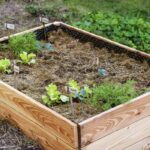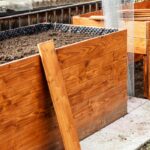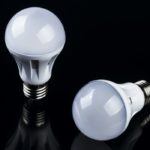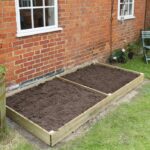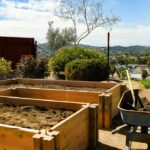Mulching is good for your raised garden as it helps to increase the overall health of the environment. It is, however, essential to choose the best type of mulch for your raised garden bed as this will ensure the optimal productivity. Still, there are several things to consider before choosing a mulch.
The different types of mulch used for raised gardens include grass clippings, compost, straw, black plastic, leaves, pine needles, cocoa hulls, and newspapers. To choose the right type, you should consider the type of crop, soil type, and climate in your area.
Let’s take a closer look at the advantages and disadvantages of mulching a raised garden. We will also discuss the various things to consider before choosing the perfect mulch and how to calculate the amount of mulch that you’ll need.
What Is Mulch?
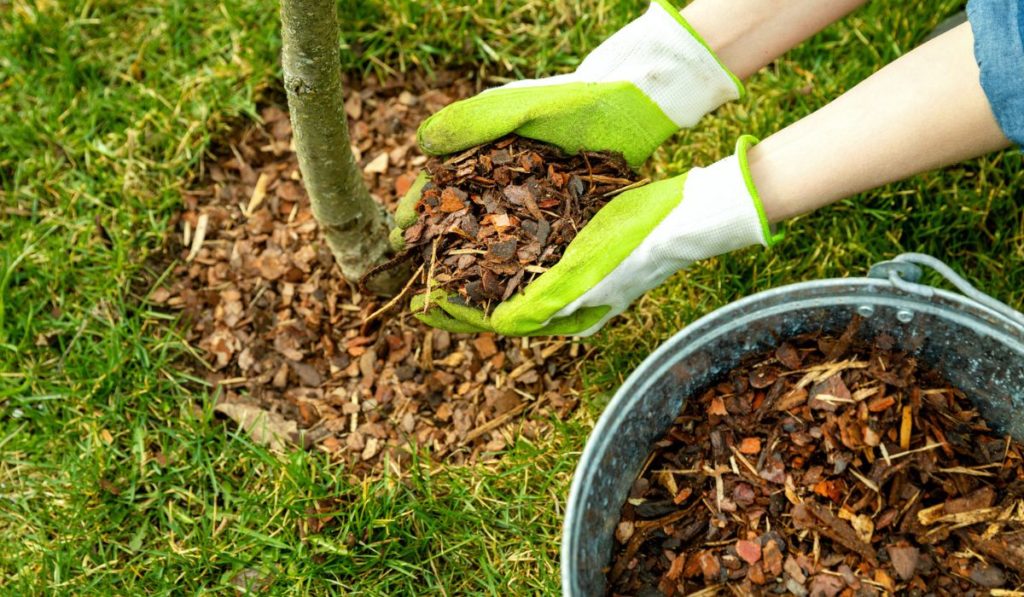
Mulch can be described as any material spread over the surface of the soil to serve as a covering. There are primarily two types of mulch: organic mulch and inorganic mulch. Mulch is usually made from materials such as the bark of trees, pine, straws, newspapers, grass clippings, manure, etc.
Mulch is an excellent addition to the soil as it has many incredible benefits. It helps to reduce soil moisture, suppress weeds, and prevent weed germination. Mulch also helps to protect the soil from extreme temperature changes, add to the aesthetic look of your garden, and some decompose organic material into the soil.
Can You Put Mulch in a Raised Garden Bed?
The use of mulch in a raised bed depends largely on what you’re growing. If you would like to retain moisture in your garden bed, suppress the growth of weeds, or regulate the temperature of the soil, then you should consider using mulch in your raised garden bed.
A raised bed drains water into the surrounding ground faster, thereby retaining moisture; using mulch in a raised bed will therefore be a wise addition.
As enormous as the benefits of mulch can be, it also has its drawbacks. Here, we’ll take a quick look at the disadvantages and advantages of including mulch in a raised garden bed.
Advantages of Including Mulch in Your Raised Garden Bed
- Regulates soil temperature: Having a layer of mulch helps to protect the soil below from rapid temperature changes. This protects the root of plants from experiencing extreme heat or cold.
- Retains moisture: Mulch is popular for retaining water in the soil beneath it. Water evaporates from the soil more slowly with a layer of mulch above it. This is essential in a raised bed where water tends to drain more quickly.
- Reduces weeds: A layer of mulch helps to suppress existing weeds and prevents weed seeds from sprouting.
- Restores nutrients: Organic mulches, such as leaves and grass clippings, help to restore nutrients back to the soil as they decompose.
Disadvantages of Including Mulch in Your Raised Garden Bed
- It can pose a danger to your plants: When you add a very thick layer of mulch to your raised garden bed, it can prevent aeration and, in turn, suffocate the plant roots.
- Decomposition: During the growing season, organic mulch decomposes and can create an unpleasant smell in your garden. It becomes even worse when decomposition depletes mitogen from the soil.
- It can lead to the rotting of stems: Mulch retains a lot of moisture, and as such, when it is placed too close to the base of a plant, it can cause the stem to rot.
- It can lead to rot of the bed: If the raised garden bed is made of wood, the trapped water in mulch can cause the wood to rot.
- It can lead to the growth of mold.
Which Kind of Mulch Is Best for Vegetable Gardens?
A well-mulched garden can reduce foliage and diseases, thereby producing more vegetables than an un-mulched garden might. However, you must choose the right type of mulch that will fit into the benefit you desire. Below are the different types of mulch and their benefits to your vegetable garden.
Grass Clippings
Using a layer of thick green grass for mulch will give off too much heat and a foul odor instead of decomposing like other organic material. Using dry grass clippings is the best as they decompose quickly and give the soil the nutrients it needs while also preventing weed growth.
Another fantastic thing is that grass clippings are not expensive; they’re simply obtained from the scraps of your lawn mower. Ensure that your grass clippings are disease-free before spreading them, as certain tainted grasses can invite pathogens to your new garden.
Also, make sure you don’t treat your grass clippings with herbicides, as these harsh chemicals can harm sensitive vegetables.
Benefits of Using Grass Clippings as Mulch
- It’s easy to access.
- It decomposes quickly and adds nutrients to the soil.
- It’s a way to recycle your own lawn nutrients.
- At the end of the season, it can be folded into the soil.
Compost
Compost is a perfect addition to many gardens. It helps to keep your roots insulated and safe. It improves the quality and structure of the soil. It also provides the soil with nutrients for a very long time. Compost comprises a mix of decomposing organic matter from table scraps and kitchen waste.
Compost serves as both habitat and food source to bacteria and earthworms that aerate your soil, release chemicals that help prevent diseases, and break down organic matter.
Earthworms are the perfect critter to make your vegetable garden thrive. While making your compost, make sure you don’t add meat, bones, and food that is high in fat.
Benefits of Using Compost as Mulch
- It provides excellent resistance against erosion.
- It breaks down and decomposes into the soil quickly.
- It’s a rich source of nutrient.
Straw
This is an excellent choice for mulching in winter. Straw is beautiful and light, and it breaks down easily, providing your plant with what they need to grow. Straw is very useful in insulating the soil, retaining moisture, and preventing heavy frosting.
It’s important that you get straw from a trusted supplier to ensure you don’t get straw with weeds. Straw is inexpensive and great at reducing compaction. To keep your vegetables safe from fungus and disease, avoid mulching directly around the leaves and stems.
Benefits of Using Straw as Mulch
- It’s inexpensive.
- It helps to reduce the need to aerate the soil.
- It regulates soil temperature in winter.
- It keeps the soil moist.
Black Plastic
Vegetables that love heat will thrive with the use of black plastic (on Amazon) as mulch. It helps to warm the soil and help with weed control. Black plastic can warm the soil temperature by up to five degrees Fahrenheit.
Heat-loving plants like okra and tomatoes mature faster with higher yields when black plastic is used as mulch. It’s advised to add a layer of another type of mulch over the black mulch so that it can last multiple growing seasons.
Black mulch breaks down easily when exposed to the sun. White or silver mulch (on Amazon) should be used if you need the soil to stay cool for plants such as peas and broccoli, as these kinds of mulch reflect heat and don’t absorb them.
Benefits of Using Black Plastic as Mulch
- Black plastic is readily available.
- It can be reused for the next growing season.
- It helps to keep the soil moist and warm.
- It helps to suppress weeds.
Leaves
Leaves that are partially decomposed are perfect for giving your garden the nutrients it needs and also for controlling weeds. A 2- to 3-inch layer of leaf mulch will do the job. Leaves are also known to improve the structure of the soil and increase water retention in the soil such that they can handle drought.
You can dig these leaves into the soil as they decompose and add another layer of mulch. Don’t add leaves from black walnut trees as they contain ‘juglone,’ a substance that can harm certain vegetables, like pepper. Avoid infected leaves so they don’t spread the infection to your lawn.
Benefits of Using Leaves as Mulch
- They’re not expensive.
- Leaves can be accessed easily.
- Leaves decompose quickly.
- Some leaves, such as oak and beech, are great additions to acid-loving vegetables
Pine Needles
Pine needles (on Amazon) are a perfect addition to your garden if you want to raise the soil acidity level. Acid-loving garden vegetables, such as celery, carrots, and potatoes, will thrive well with pine needles.
Pine needles interlock such that they won’t get blown away on windy days. They’re also resistant to soil compaction such that your garden soil remains porous and healthy. There’s also need to worry about pine needles acidifying your soil permanently since they neutralize decomposition.
Benefits of Using Pine Needles as Mulch
- They’re not expensive.
- They last for a long period, about 2 to 4 years.
- As they age, they release a pleasant aroma.
- They’re aesthetically appealing.
Newspaper
Old newspapers lying around can provide you with free mulch. They’re biodegradable and are especially useful in suppressing weeds. You must soak the newspaper sheets with water as you spread them so they can stick together.
You can also apply organic mulch over the newspapers to hold them down and provide maximum insulation. Newspaper returns nutrients to the soil and improves soil composition as they decompose. To keep your vegetables healthy, you should add nitrogen fertilizer to your veggies. This is because newspapers can rob the surface of the soil of nitrogen.
Avoid using glossy color inserts over your soil as they don’t decompose like regular newspaper and harm your plants.
Benefits of Using Newspaper as Mulch
- It helps to suppress weeds strongly.
- It’s not expensive.
- It’s biodegradable.
- It’s readily available.
Cocoa Hulls
Cocoa hulls (on Amazon) add elegance to your vegetable garden. They resist compaction, have a nice chocolatey smell, and attract earthworms. This makes the soil rich in nutrients, airy and light, a perfect condition for vegetables to grow.
Don’t add cocoa hulls to an area that pets can easily access as they contain theobromine, a substance that is toxic to dogs.
Benefits of Using Cocoa Hulls As Mulch
- They’re easy to apply.
- They’re not expensive.
- They resist compaction.
- They suppress weeds strongly.
- They have a very high visual appeal.
How to Choose the Right Kind of Mulch for Your Garden
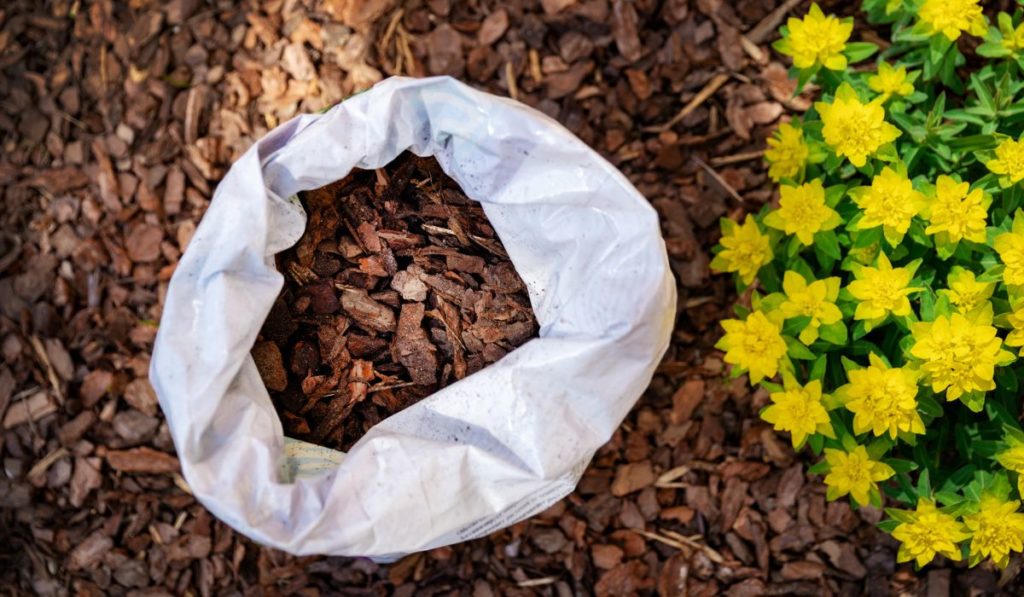
You need to select the best mulch for your garden as this can help improve the overall health of your plants. There are certain factors to consider that will help you choose the right kind of mulch for your garden. These factors include the following;
The Crop
There are different types of vegetable plants, and these plants require different growing conditions. It’s essential to understand the type of plant you’re growing so that you can grow it under its ideal conditions and yield maximum returns.
Vegetables that require heat, such as melons, tomatoes, and eggplants, are suitable for black plastic mulch. Black plastic mulch is, however, not ideal for cool-weather crops such as broccoli and greens. Straw, shredded leaves, newspapers, or paper mulch will be perfect for cool weather crops.
The Soil Type
It’s always wise to consider the soil type in your garden before selecting a suitable mulch. Oftentimes, vegetable plants don’t do well in heavy and wet soil. As such, this type of soil usually dries out as the season progresses; you shouldn’t cover such soil with thick and moisture-retentive mulch.
In the same way, dry and sandy soil shouldn’t be covered with plastic mulch as this will prevent rain and irrigation water from getting to the roots.
The Weather
The type of climate you live in is a significant factor in deciding the type of mulch to use for your garden. For those living in hot climates, plastic mulches should be used judiciously. High soil temperature will stress your plants and burn up organic matter. In hot weather, plants will benefit more from soil cooling mulch such as straw or shredded leaves.
In the same way, if you live in a cool climate where even the summers are cool and wet, plants will not benefit from soil cooling mulch.
The plants can be stunted from cold or turn yellow due to too much moisture. What you should do in this case is to allow the soil to warm up and dry out before applying a soil-cooling mulch.
During early spring, you should consider using plastic mulch to raise the soil temperature and also dry the soil out.
How Much Mulch Do You Need for a Raised Bed?
After deciding on the type of mulch, you will need for your garden, the next thing to do is to calculate the amount of mulch you will need to buy. If you guess the amount of mulch, you’ll likely either end up with too much or not enough.
Calculating the Amount of Mulch Needed for a Rectangular Garden
First, determine the size of your garden bed, which will help determine the amount of mulch you need. For rectangular or square beds, start by measuring the length and width of the bed in feet. Then you can multiply these two to give you the area, or square footage of the garden bed.
After this, determine how deep you want to layer the mulch. Usually, two or three inches is the required depth for the garden beds. Finally, multiply the square footage of your bed with your desired depth. This would give you the total amount of mulch needed.
For example, if we have a length of 20 feet and a breadth of 10 feet, then the square footage is 200 square feet. Then, if we want a depth of 3 inches (0.25 of a foot), the amount of mulch needed is 50 cubic feet.
Calculating the Amount of Mulch Needed for a Round Garden Bed
Calculating the amount needed for a round garden bed follows the same method, with a bit of variation. To get the area of the round bed, you need to measure the diameter of the garden bed.
After that, divide the radius by two and square it. Multiply the result by 3.14 to get the area of the bed. Multiply by the depth you desire.
The final thing to do is to convert your desired square footage of mulch to cubic yards. Mulch is sold in cubic yards. To do this, you should divide the total square footage by 27.
When Should You Add Mulch to Your Vegetable Garden?
The time to mulch your vegetable garden mainly depends on the type of vegetable you’re growing and when you plant them.
Cool-season vegetables are planted during early spring. The sun warms up the soil in the spring, and these young plants get off to a quick start.
It would be best if you lay the mulch when the soil starts to warm up and the soil needs regular water. Mulching too early will make the soil too wet and cold, which is inappropriate for root growth.
For cool-season vegetables that are planted in late summer or early fall, you want the cooling effect to be felt, and as such, you should lay the organic mulch right after you plant.
For warm-season vegetables that are planted during spring, the ground should be kept clear if you’re planting early. The more heat for these kinds of vegetables, the better. Apply the organic mulch during the summer when the weather gets very warm.

